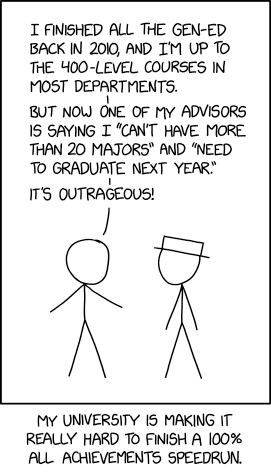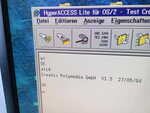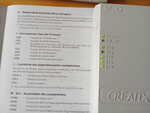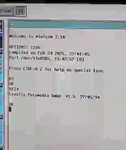@aelaraji@aelaraji.com Yes, exactly. It also blows my mind that with sooo much less budget and equipment, her videos are way superior to productions of big TV stations.
can somebody please transcribe what he said and post it here? 🙏 I think it’s too good just to waste in a video it needs to be preserved. 🤣
Fuck me, soooooooo beautiful! Awwww! :‘-) https://www.youtube.com/watch?v=oYfKgi133qo
This focuses more on the landscape part, other episodes also have amazing interactions with the locals. I cannot recommend the Itchy Boots channel enough. It’s in my top three channels of all time I believe. I hardly get the travel bug, but this has now changed. Watching Noraly’s videos brings me great joy. It also shows humanity is not lost, contrary to what one might think in this crazy world. :-)
Caution, this channel gets very addictive!
@bender@twtxt.net are you able to send me a video recording of how that sounds because I don’t think that that’s what they called it at the breakfast? 🤣
@movq@www.uninformativ.de how long do they need to read the scale? LOL. The penguin stayed put at least twice, no issues. I think the creator wanted some Internet points out of that video. 😂
@kiwu@twtxt.net Only thing i can find that meets your requirements is the ORDRO HDV-V12 HD 1080P Video Camera Recorder Is 80m of video rexorsinimg enough for you?
I’m gonna ask here again because I’m really frustrated and literally no one else is responding anywhere can u guys please help me find a good video camera the biggest think I want is long battery life but I also want it to be cheap like under $200, if you yourself don’t know please ask a friend because I am not a tech nerd and looking for stuff like this is very hard for me
@movq@www.uninformativ.de great video. I don’t agree with everything, especially the modern websites highlighted as not that bad, but definitely agree, with the main point. https://youtu.be/2z7kVH9xePM
@kiwu@twtxt.net I’ve no idea about regulations in your area, but over here there are different taxation rules for video and photo cameras. Hence, manufacturers limit the video recording time of photo cameras typically to half an hour, so that they don’t classify as video cameras with their higher taxes.
@bender@twtxt.net a mobile phone camera doesn’t cut it because it cant take long videos. I would say like the cheapest possible tbh! it doesn’t have to be an amazing grade a camera, just something that will record in decent quality for long periods of time! I mostly want it to make vlogs :p
@kiwu@twtxt.net It also greatly depends on what kind of videos you plan to record. When you go, let’s say, diving, the specs need to be probably more suited to that type of environment. What about zoom, macro shots, wide landscapes, and so on? When typically mounted on a tripod, I’d say builtin image stabilization is not required, but for more action shots, this is fairly important to not get sea sick. :-)
I’ve got a Nikon Coolpix S9300. I typically only take photos, but it also works for the occasional video. Free hand moves are quite difficult, but when mounted to a tripod, this is not too shabby. There’s absolutely no way around a (makeshift) tridpod when zooming in, though. The audio is definitely not the best, especially wind destroys everything. If I recorded more video, I would certainly want to have an external microphone.
I have a question! I’m looking for a small personal camera(specifically good for videos because that’s what I’ll use it for) that’s cheap enough for a teen to afford but also actually good. Do any of you tech people have any good recs?
I was having a stroll and heard this weird crackling noise. Took me a moment to realize that it’s coming from the tree above me. I looked up and didn’t see anything at first, because of the bad light. And then I saw it: About 10 parrots (alexandrine parakeets or rose-ringed parakeets) were sitting up there, heaving a feast. 😅
https://movq.de/v/3527326471/parrots.mp4
(Video isn’t great, because this is my smartphone and the light was bad.)
@movq@www.uninformativ.de Have we reached peak enshittification yet?
YouTube is completely broken for me for a week or more. The player doesn’t even load anymore. Trying to limit the search results to real videos doesn’t do shit, etc. It’s useless. But downloading the videos with yt-dlp still works like a dream.
I have now permitted the following media types:
image/*
audio/*
video/*
text/*
Repair Video
 ⌘ Read more
⌘ Read more
@lyse@lyse.isobeef.org now that I could finally read you RSVP message (or, should I say, essay, LOL), I had to see the video, and well, https://netbros.com/1761846417/. Hahahahaha!
Triad Prague, is perhaps the only mainstream “Contemporary advertising” company, who fucking AI generates “pixelart” and everyone there is either too blind, dumb, or lazy, to at the very least, align the pixels, to a grid (or even check they’re square, the same size,…anything really).

I guess they must have some remains of shame and self preservation instinct, that made them sweep these off their portfolio website and set the video ads with them, to “Private” on YouTube.
https://youtu.be/s7GZK8FGRvA
But sadly not enough shame, to stop putting these on billboards, I have to see on daily basis and making new versions of them, with different inconsistent styles, of badly AI generated “pixelart”!

I checked their website, this is their footer, with the text that always overlaps - maybe they also never heard about CSS, can’t blame them, it’s only been a thing, since 1996.

I don’t care much for the video, but damn, that is one catchy song. 🎶 https://www.youtube.com/watch?v=ko70cExuzZM
I noticed Google put out this article: https://android-developers.googleblog.com/2025/09/lets-talk-security-answering-your-top.html it’s very current day Google, but the comments under the YouTube video are pretty on point and I saw a few familiar faces there. There is also, unexpectedly, ways to contact Google.
First a form for “teachers, students, and hobbyists”, that I filled politely, as someone who falls under their hobbyist category. It can be filled both anonymously, or with an e-mail attached, to be contacted by them (I chose the second option).
Also a general feedback and questions form, that I was not as polite in and used to send them the following message:
I have already provided some feedback, in the teacher, student and hobbyists form/questionaire, as well as an open letter I’ve recently sent to the European Commission digital markets act team, as I do believe your proposal might not even be legal, given the fact it puts privacy-focused alternative app stores at risk (https://f-droid.org/cs/2025/09/29/google-developer-registration-decree.html) and it was proposed this early, after Google lost in court to Epic Games, over similar monopoly concerns. Why should we trust Google to be the only authority for all developer signatures, right after the European courts labeled it a gatekeeper?
Assuming this gets passed, despite justified developer backlash and at best questionable legality, can you give us any guarantees, this will not be used to target legal malware-free mods, or user privacy enhancing patchers, like the ones used for applying the ReVanced patches? I have made a few mods myself, but I am in no way associated with the ReVanced team. I just share many peoples concerns, Google Chrome has been conveniently stripped of its manifest v2 support, that made many privacy protecting extensions possible and now you’re conveniently asking for the government IDs, of all the developers, who maintain these kinds of privacy protections (be it patches, or alternative open-source apps) on Android.
@prologic@twtxt.net Oh, that’s cool! :-) Feeding magpies seems to be an Aussie thing, the Cutting Edge Engineering Australia videos usually also include a cute magpie feeding clip.
@bender@twtxt.net Off you go to the magpie hunt! We wanna see Florida pies!
100% All Achievements
 ⌘ Read more
⌘ Read more
@bender@twtxt.net @movq@www.uninformativ.de Thank you! Not sure what I end up putting in there, but I’m sure I will find some tools to go in. :-)
Yes, this was a flat piece of sheet metal. It went together like a cardboard box, just much slower and with timbers clamped down to get a straight folding line. I don’t have a sheet metal brake, so I just carefully hammered the piece bit by bit. Like in this video by the Sheet Metal Dude: https://www.youtube.com/watch?v=WYgEfWEMXk0
@lyse@lyse.isobeef.org I give up. Just doesn’t give me a 360° video. 🥴 Maybe I’m just having bad luck with YouTube’s randomized stuff (maybe I’m getting “experiments”, who knows) …
yt-dlped https://www.youtube.com/watch?v=OZTSIYkuMlU. It's only worth for an experiment, no recommendation to watch.
@lyse@lyse.isobeef.org that’s pretty cool! The first video I see on YouTube of that kind. Thanks!
@lyse@lyse.isobeef.org I can’t remember the last time I came across a 360° video. 🤔
@lyse@lyse.isobeef.org is it a 360 degree video online, or a local one?
Whooooaaaah, I just accidentally found out that VLC can play 360° videos and I am able to pan around! Crazy shit. I actually scrolled in order to adjust the volume like it usually works, but it zoomed in and out instead. Then I saw the title hinting at the 360° stuff. Even though this is not my cup of tea, it’s nice that VLC supports it.
we are now parsing and recursively fetching remote feeds somewhat successfully, gotta work on the media proxy and markdown way more, so so many fucky edgecases….my friend’s feed with like four posts parsed correctly so i tried this account’s feed and well now im not going to bed on time
edit: remaking demo video
we are now parsing and recursively fetching remote feeds somewhat successfully, gotta work on the media proxy and markdown way more, so so many fucky edgecases….my friend’s feed with like four posts parsed correctly so i tried this account’s feed and well now im not going to bed on time
search page, bookmarks page, improved thread view (that i will probably improve further), as well as a logo and a whole ui redesign. it is truly all coming together…were i to mark any items off the roadmap :p
@kat@yarn.girlonthemoon.xyz this is from the video for her song “oops!” – check it out! https://www.youtube.com/watch?v=sOV1vApNIuk
and when suzuki airi world domination comes, you can consider yourselves ready because i showed you this video ;)
replies and following implemented! next step is further parsing of post contents, rendering threads, and then maybe i can finally start adding remote feeds…! though i kinda wanna redo the whole ui ^^’
really proud of how bbycll is coming along!!
@lyse@lyse.isobeef.org Yeah, removing the cover will probably help. I’ll have to try. 😅 And, yes, the scrolling is pretty annoying (and kind of ruins the experience a little bit).
The printer isn’t that loud – at least not for a dot matrix printer. 😅 It’s been ~30 years since I’ve last seen them in person, but I remembered these things to be louder. I’m typing on my Model M, maybe that contributes to the perceived noise on this video. Here’s an isolated recording of that keyboard: https://movq.de/v/ddc98b03d8/2022-02-21–model-m-goes-brrr.ogg 🤣 It really sounds like that when you’re typing fast. Brrrrt.
@thecanine@twtxt.net Oh! 🤯 Hadn’t heard of this before. And 100% agree with that video.
@movq@www.uninformativ.de Yeah I just got a bit curious after watching your video and reading your OP 😅
@lyse@lyse.isobeef.org When/if I can pull it off, there will be videos! 😅
I never used hardcopy terminals, either. We did have a dotmatrix printer, but that was just used as a regular printer.
Inkjets, I don’t know. They were pretty fascinating and cool when they came out. A lot faster than dotmatrix and obviously quiter. They never gave me much trouble, actually. But I switched to a laser printer long before crap like DRM’ed ink cartridges became a thing.
@movq@www.uninformativ.de Heck yeah, have fun! :-) We never had a matrix printer, started off with a cathode ray tube and an inkjet pisser.
I’m happy to see you compose your first twtxt message using ed on your new output device. We definitely need video proof of that! ;-)
I have a Python script that transforms the original YouTube channel Atom feed into a more useful Atom feed by removing the spam description and replacing it with the video duration, filtering out videos by title, duration, etc. I just updated it to exclude the damn Shorts garbage more efficiently. Finally, YouTube updated their Atom feed generation, so that the video URL contains /short/ if it’s of this useless kind. Never thought that they ever actually will improve their Atom feeds. Thank you, much appreciated!
@kat@yarn.girlonthemoon.xyz I have absolutely no idea, but I wouldn’t be surprised if it uses the closest full image after your cut point and not the one before. Hence, the deltas between the two full images have nothing to really refer to. So, the video player just shows the first full image it finds and “freezes” the image until the video stream actually hits it.
Let me try to visualize it, | represent full images, . just subsequent deltas:
Original start of video
↓
|......|.....|........|......|..
↑ ↑
Cut point Cut point
Resulting video:
....|.....|........|....
↑↑↑↑
This is where it freezes
Could be complete bullshit, though. Wouldn’t be the first time that I’m wrong. :-)
I’m just curious, what exact command line do you use to cut the video?
@kat@yarn.girlonthemoon.xyz why does ffmpeg always freeze the video in the first five seconds after a cut lmfao
I bought the “remastered” versions of Grim Fandango and Forsaken on GOG, because they’re super cheap at the moment. Both have native Linux versions.
And both these Linux version crap their pants. 🫤 The bundled SDL2 of Forsaken says it “can’t find a matching GLX visual” and I couldn’t figure out how to fix that. I didn’t spend a lot of time on Grim Fandango.
Both work great in Wine. 🤦
(I do have the original version of Grim Fandango from the 1990ies, but that one does not work so well in Wine. I figured, if it’s so cheap, why not. And I now get to play the english version. 😃 The german dub is pretty damn good, actually, but I always prefer the original these days.)
I’m trying to think of what topic to bitch abt for my next video no one asked for 🤔
Thanks @bender@twtxt.net! Yeah, so super cute. I couldn’t pet them, though. Despite very curious, they were also very restless.
I persuaded my dad to check out the fireflies with me tonight. He only wanted to go for a short trip, so we came just across a couple hundred of them. Otherwise, the thousands mark would have been exceeded in no time. He was super glad I talked him into that. :-)
It was also my first time to see them over the meadows. Those numbers don’t compare to the ones inside the forest, no question, but we probably saw 60 or so. Haven’t come across them there before, I only heard and read about that.
Note to future-Lyse next year: Leaving at 21:45 seems like a good time. We left earlier and had to wait just a few more minutes for them to come out in masses.
Too bad it’s impossible to share photos or videos. My camera isn’t made for that at all, not even close.
@movq@www.uninformativ.de Oh, really!? You should come visit. :-)
As far as I know females are sitting in the shrubs and males fly around, but they’re not all that quick. They are slowly moving glowing dots that you can easily follow with your eyes. The bigger problem might be that they turn off and then on again. So, one could count duplicates. However, there’s typically a bit of distance between them (at least 30-50 cm I’d say, often more). Counting the same individual multiple times is not all that common (assuming that they don’t speed up when turned off). My counting was also conservative I believe.
Ah, Die Maus also covered them a few days ago: https://www.youtube.com/watch?v=OVGD5QEvtoc
At the end, there’s a video were you can see the speeds a bit.
@kat@yarn.girlonthemoon.xyz i linked the normal length edit instead of the full 15 minute music video because i’m not gonna subject you all to that amount of my bullshit
(…15 minute version is a great watch though)
STOP! this is a dambara ruru video checkpoint. you must watch this video or else i will find you
Maybe you’ll enjoy this as well:
I still have one of my first modems, a Creatix LC 144 VF:
I think this was the modem that I used when I first connected to the internet, but I’m not sure.
I plugged it in again and it still works:
The firmware appears to be from 1994, which sounds about right. I don’t think we had internet access before that. We certainly did use local mailboxes, though. (Or BBS’s, as you might call them.)
I now want to actually use that modem again. For the moment, I can only use a phone to dial into it, I lack a second modem to actually establish a connection. Here’s a video:
Not spectacular, but the modem does answer after me entering ATA.
I bought another cheap old modem on eBay and am now waiting for it to arrive. Once it’s here, I want to simulate an actual dial-up session, hopefully from OS/2 or Windows 3.x.



